With its thermal springs and geothermal systems representing active examples of epithermal gold processes, Rotorua is the perfect location for the Gold’17 Symposium in February 2017. The conference is being convened jointly by the Australian Institute of Geoscientists (AIG) and Geoscientists Symposia. It continues the regular series of gold events that commenced with Gold’82 in Zimbabwe and was followed by meetings in southern Africa, Australia and the Americas.
This is the first time the event has been held in New Zealand.
“This conference is shaping up to be the most important gold geoscience conference since Gold14@Kalgoorllie in 2014” said the symposium Organizing Committee Chairman and industry consultant Julian Vearncombe. It provides three days of talks and posters on various aspects of gold deposits, provinces and exploration, and networking opportunities with some of the world’s foremost experts, making it an essential event to attend for mineral exploration and research geoscientists.
Rotorua is often referred to as the ‘Lake District’ because of the number of fishable lakes within its boundaries. It was historically New Zealand’s first tourism destination, because of thermal features such as the Pink and White Terraces destroyed in the 1886 Tarawera eruption. Rotorua continues as the centre for geothermal attractions and visitors are immediately aware of the geothermal environment because of the characteristic scent of sulphur in the air.
The symposium will be a truly international event, with keynote speakers from Canada, the USA, Australia and New Zealand. The meeting will focus on developments in gold mineral systems, exploration technologies, opportunities and Pacific margin geology and mineralisation. Field trips will visit gold mines in Otago and Waihi, and the hydrothermal systems of the Taupo Volcanic Zone. Short courses will critically compare the New Zealand mineralisation with that elsewhere around the Pacific Rim.
The goal of Gold17@Rotorua is to present the innovative geological practices and technological innovations that are contributing to the continued success of an industry that employs 800 in New Zealand, and 25,000 personnel across Australia.
Symposium sponsors include OceanaGold, the AusIMM, GNS Science and NZ Petroleum and Minerals.
For further information contact
Julian Vearncombe in Australia
t: +61 437477220
Tony Christie in New Zealand
t +64 211759307
e: rotoura2017@geosymposia.com.au
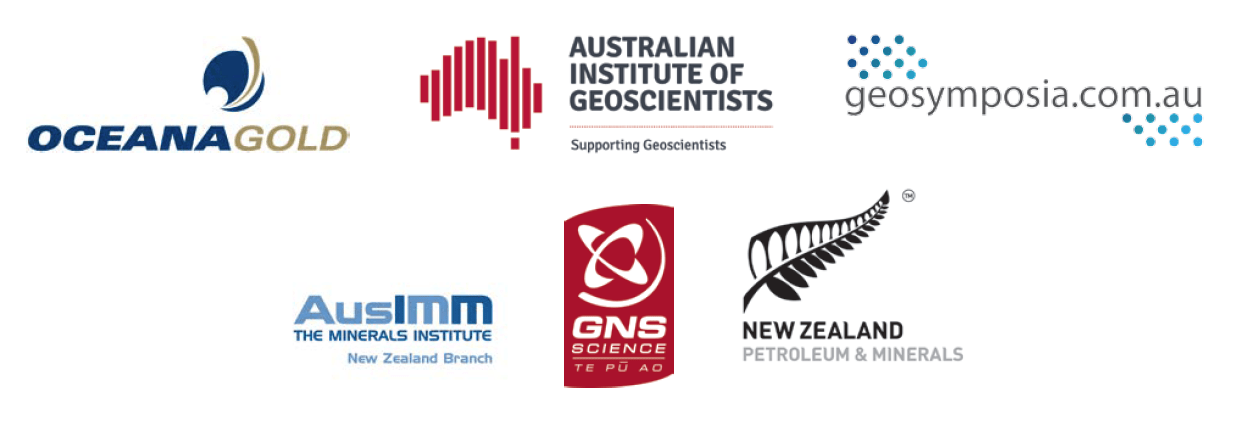
New restrictions on forward looking statements introduced by the Australian Securities and Investments Commission (ASIC) have attracted criticism by junior sector exploration and mining companies. The Australian (16 May 2016) reported that the Association of Mining and Exploration Companies (AMEC) is preparing to appeal directly to federal Resources Minister Josh Frydenberg for intervention over the regulator’s latest rule changes immediately following the upcoming Federal election.
ASIC last month released new guidelines that restrict what junior exploration companies can say about the economic potential of their discoveries.
AMEC, on behalf of its members, are arguing that the changes will create a less transparent market and make it even harder for explorers to secure funding.
The Australian reported that under the rules, companies are restricted from disclosing project economics to their investors if the company does not have “reasonable grounds” to believe they have funding in place for the project’s development.
That restriction has been seen within the industry as a Catch-22 situation, given the release of the economic potential is a crucial stepping stone in raising both money and market capitalisation.
AIG has consistently advocated that measures which unnecessarily stifle investment in exploration and mining are damaging employment prospects for geoscientists and placing renewal of Australia’s mineral resource project pipeline at risk. The JORC Code, last revised in December 2012, already provides standards for the content forward looking statements made by exploration and mining companies, intended to ensure appropriate, transparent disclosure of information for the =benefit of investors.
Click here to read The Australian’s report on this issue.
Andrew Waltho
20 May 2016

A long-running quarterly Queensland Resources Council survey of resource company CEOs has found that confidence in the regulatory environment in Queensland is at a near-five year low.
QRC Chief Executive Michael Roche said compared to a year ago, the latest findings revealed a stark change in the confidence of the CEOs confidence about regulation and doing business in Queensland.
‘This time a year ago after a change of government in Queensland our sector deemed it business as usual for the resources sector, but in the space of 12 months a lot has changed,’ Mr Roche said.
‘While the Labor Government’s commitment to royalty stability for its first term of government is welcome there has been anything but stability elsewhere in the regulation of the sector.
‘Our sector has been the target of a raft of regulatory changes – some enacted – and many more proposed – therefore it’s little wonder the resource leaders’ sentiment has substantially changed.’
The survey also reveals that 44 percent of CEOs said that costs such as infrastructure charges, royalties and other taxes and charges were somewhat of significantly more expensive in Queensland than in other jurisdictions.
‘One of the biggest issues facing our sector is that in recent years the sector has been loaded up with significant increases in local government rates and this came to the fore in the comments from the sector bosses,’ Mr Roche said.
As one company CEO put it:
“See how long a mayor would last if they proposed a 500 percent increase on all ratepayers.”
Mr Roche said the majority of respondents to the survey did reveal that if the state government were able to reduce industry costs such as royalties this would improve the business outlook.
‘While the QRC is getting a good hearing from Treasurer Curtis Pitt and Mines Minister Anthony Lynham, elsewhere our government continues to deliver nasty surprises and poor policy,’ Mr Roche said.
‘I have written to Premier Annastacia Palaszczuk in the wake of the results from our latest survey in the hope that the government will recognise the damage being done to industry confidence due to the uncertainty.
Mr Roche said that the so-called Chain of Responsibility law enacted just over three weeks ago is causing enormous angst and uncertainty in the business community.
‘QRC had no disagreement with the government’s intent with that new law but, as we feared, it has gone too far and is doing serious damage to investor confidence.
One CEO put it this way in responding to the QRC survey:
“Recent state government proposals and regulatory changes appear reactionary and populist.”
‘The QRC is working with companies and the government to make this a great state to do business in, but if the government’s approach towards policy and regulatory stability does not change then investor confidence could keep spiralling down further, leaving taxpayers out of pocket.
‘The resources sector contributes directly and indirectly one in every $5 of the State’s economy and is responsible for one in six jobs, while also contributing $2.1 billion in royalties to the government in the last financial year.
‘That $2.1 billion was the equivalent of funding the salaries of 35,000 teachers, 30,000 nurses or about 32,000 police officers.
‘The state collects zero royalties from mines that close and from projects that are cancelled.’
Queensland Resources Council, 16 May, 2016
The results of an election to fill seven AIG Council positions was announced at the Institute’s Annual General Meeting in Perth this evening.
The following members were elected to Council:
The special resolution to adopt a new Constitution for the Institute was overwhelmingly supported by members.
Mr Phil Lewis of Elections Australia Pty Ltd, Sydney, was the Returning Officer for both polls.
Congratulations to our seven newly elected and re-elected Councillors.
Employment prospects for Australia’s professional geoscientists deteriorated even further in the opening quarter of 2016, driven down by mining’s negativity and dashing hopes for an improvement in the geoscientist employment situation.
Around half of the unemployed has now been jobless in the sector for 12 months – and around two thirds of jobless have no expectation of returning to their chosen craft anytime soon.
The picture emerged in results of the latest quarterly survey by the Australian Institute of Geoscientists (AIG) in which respondents provided information about their employment prospects during the first three months of 2016.
The figures reinforced that geoscientist employment in Australia has been in continuous decline since September 2011 and has been at Global Financial Crisis levels or worse since September 2013. Alarmingly, the new March 2016 results broke previous “worst” records, crashing further to the lowest measure of geoscientist employment conditions in Australia since these surveys commenced in June 2009.
At 31 March 2016, the unemployment rate amongst Australian geoscientists was 19.5% and the under-employment rate remained at 23.4% (Figure 1).
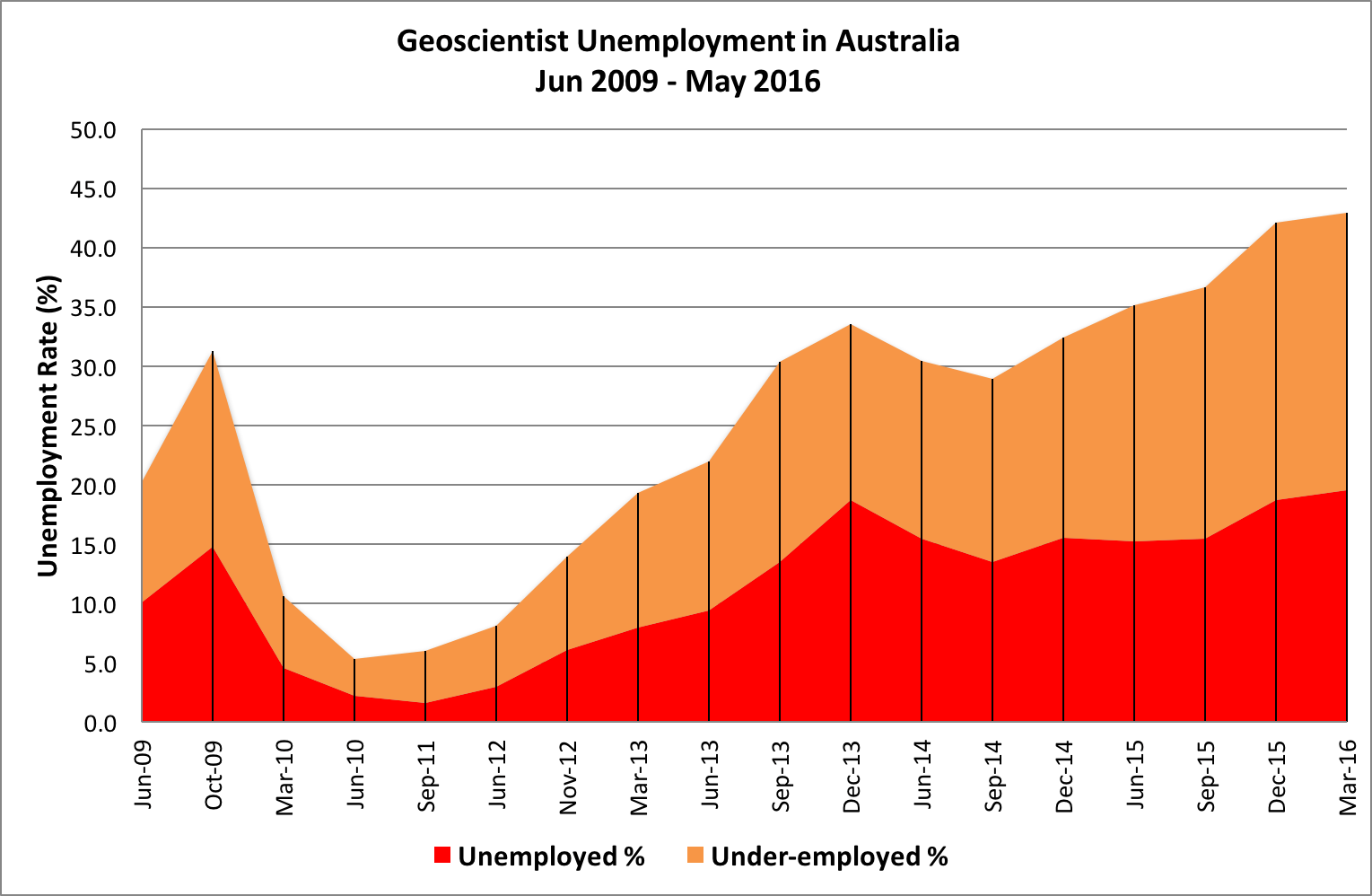
Figure 1. Geoscientist unemployment and under-employment in Australia June 2009 – March 2016
The survey received excellent support with 1013 responses in all. The last Australian census indicated that there are some 8,000 people with geoscientist qualifications in Australia, not all of whom are pursuing a career in the profession.
The unemployment rate increased from 18.7% at the end of December 2016, and the combined unemployed + underemployed rate increased from 42.1% at the end of December 2015 to 42.9% at the end of March 2016.
Almost 60% of self-employed geoscientists were unable to secure more than one quarter of their desired workload during the quarter, pointing to a real unemployment rate of 33.3%.
The employment survey results for different states were mixed. The highest combined rate of unemployment and underemployment was evident in Queensland, followed by New South Wales and the Australian Capital Territory. The combined unemployment and underemployment rate was very similar for Western Australia, Victoria and South Australia (Figure 2). The composition of the overall figures, however, varied between these three states with unemployment higher in both Victoria and South Australia than in Western Australia.
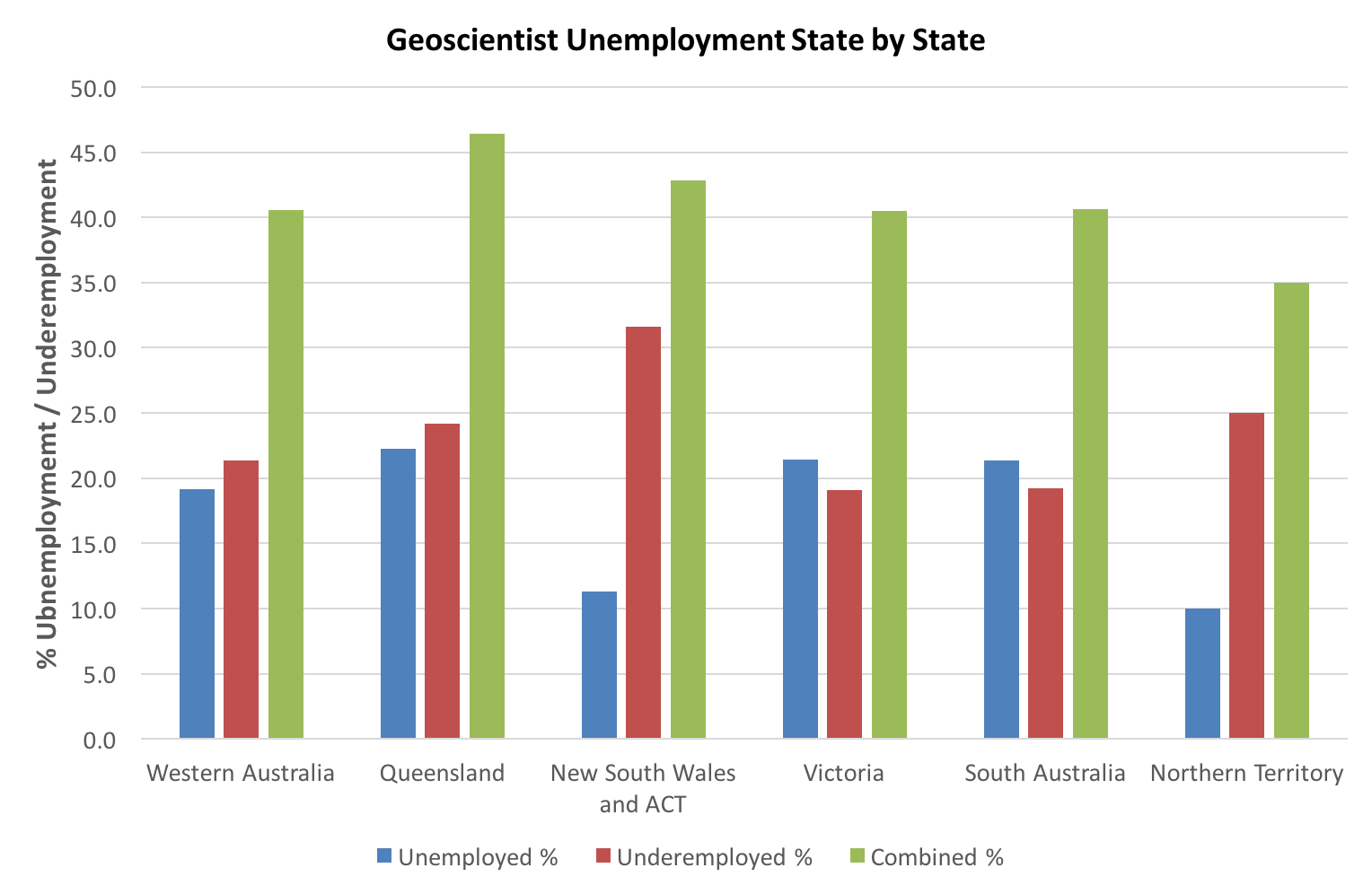
Figure 2. Geoscientist unemployment and underemployment by State
The increasing unemployment and underemployment trend was also not uniform across Australia (Figure 3). Both unemployment and underemployment increased marginally in Western Australia. In Queensland, however, unemployment increased by more than 5% while underemployment amongst self-employed geoscientists decreased. Both unemployment and underemployment increased in New South Wales. In Victoria, unemployment increased significantly while improved demand for self-employed geoscientists’ services was evident. In South Australia, unemployment was unchanged while underemployment amongst self-employed geoscientists fell. In the Northern Territory, geoscientist unemployment fell sharply, but underemployment amongst self-employed geoscientists increased. The results for the Northern Territory are influenced by the small number (20) of survey respondents primarily seeking work there.
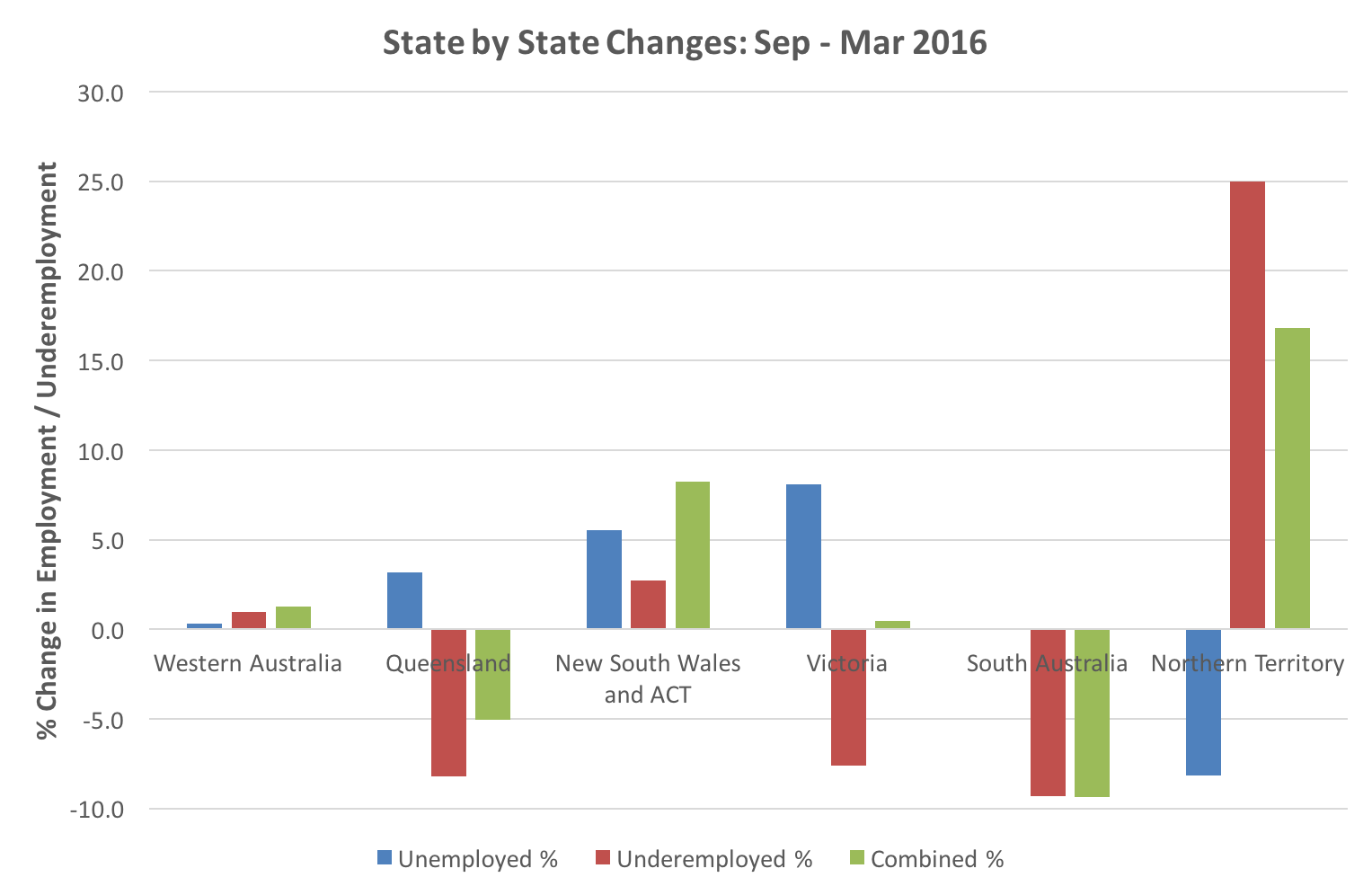
Figure 3. Changes in state unemployment and underemployment during Q1 2016
Some 49%, almost half, of Australia’s unemployed and underemployed geoscientists have been without work for more than 12 months, an increase of 5% since December 2015 (Figure 4). More than 67% of unemployed and underemployed respondents were not confident of regaining employment within the next 12 months. Less than 5% of unemployed and underemployed geoscientists were confident of regaining employment within 3 months. 14% of unemployed and underemployed geoscientists were seeking long-term employment outside their profession, up from 9% in the previous survey.
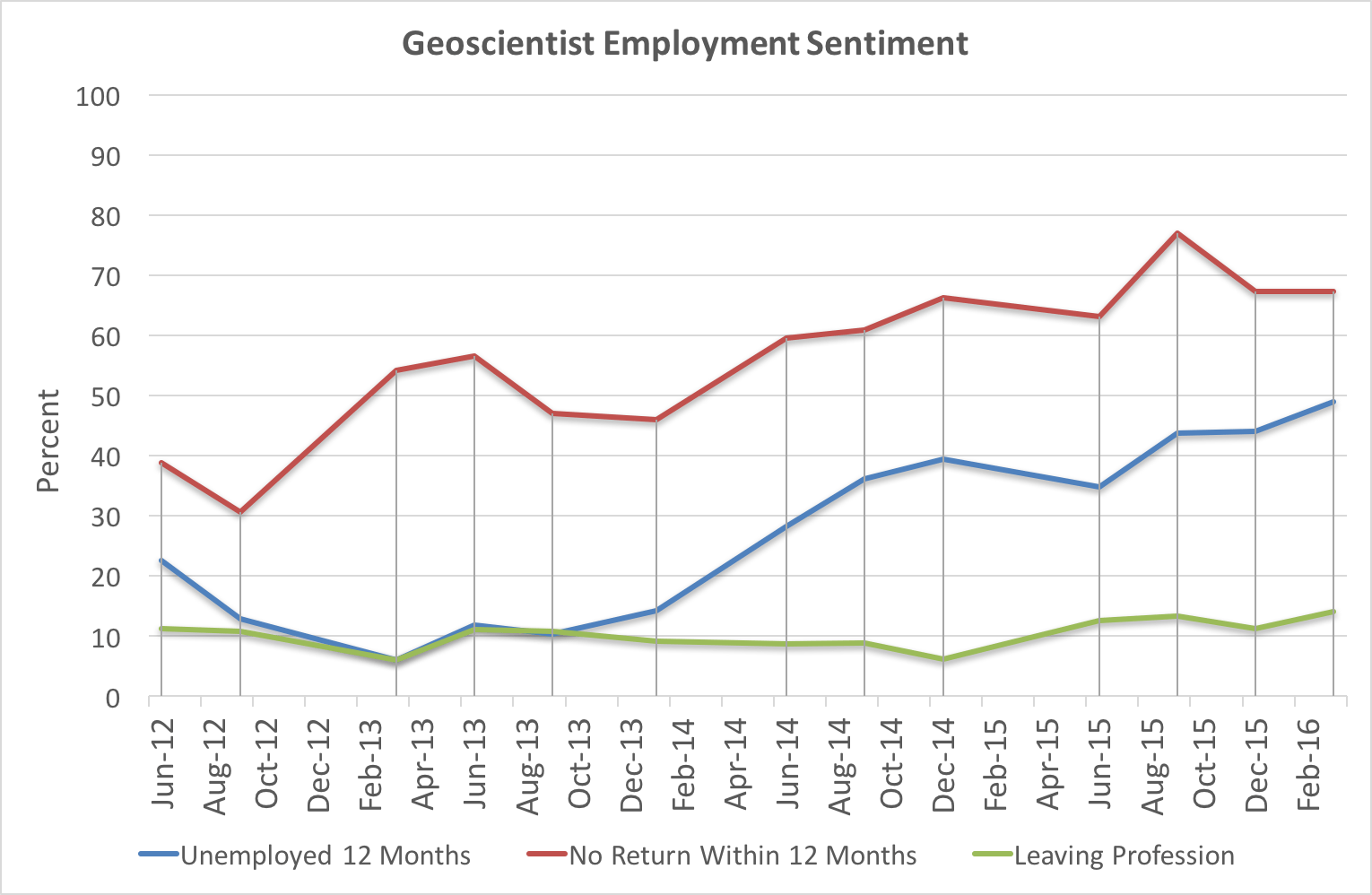
Figure 4. How Australia’s unemployed and underemployed geoscientists view their prospects
Unemployment and underemployment is affecting geoscientists with all levels of experience, from new graduates to seasoned professionals (Figure 5). The rate of unemployment in five year groups between 0 – 5 years and 20 – 25 years was essentially constant, at around 10% in each category. The unemployment and underemployment rate, however, increases to around 15% in the 25 – 30 year category, and almost 35% in the greater than 30 year category which is concerning as it points to some of the most experienced professionals in Australia not being able to contribute to the mentoring and professional development of their younger colleagues, and to important lessons learned in the past potentially being forgotten. The latter issue compounds the problem of cyclicity in employment affecting Australia’s resource industries, where the “boom and bust” nature of the sector impedes productivity through the loss of corporate knowledge and repetition of previous work, particular in exploration and discovery of new minerals and energy resources.
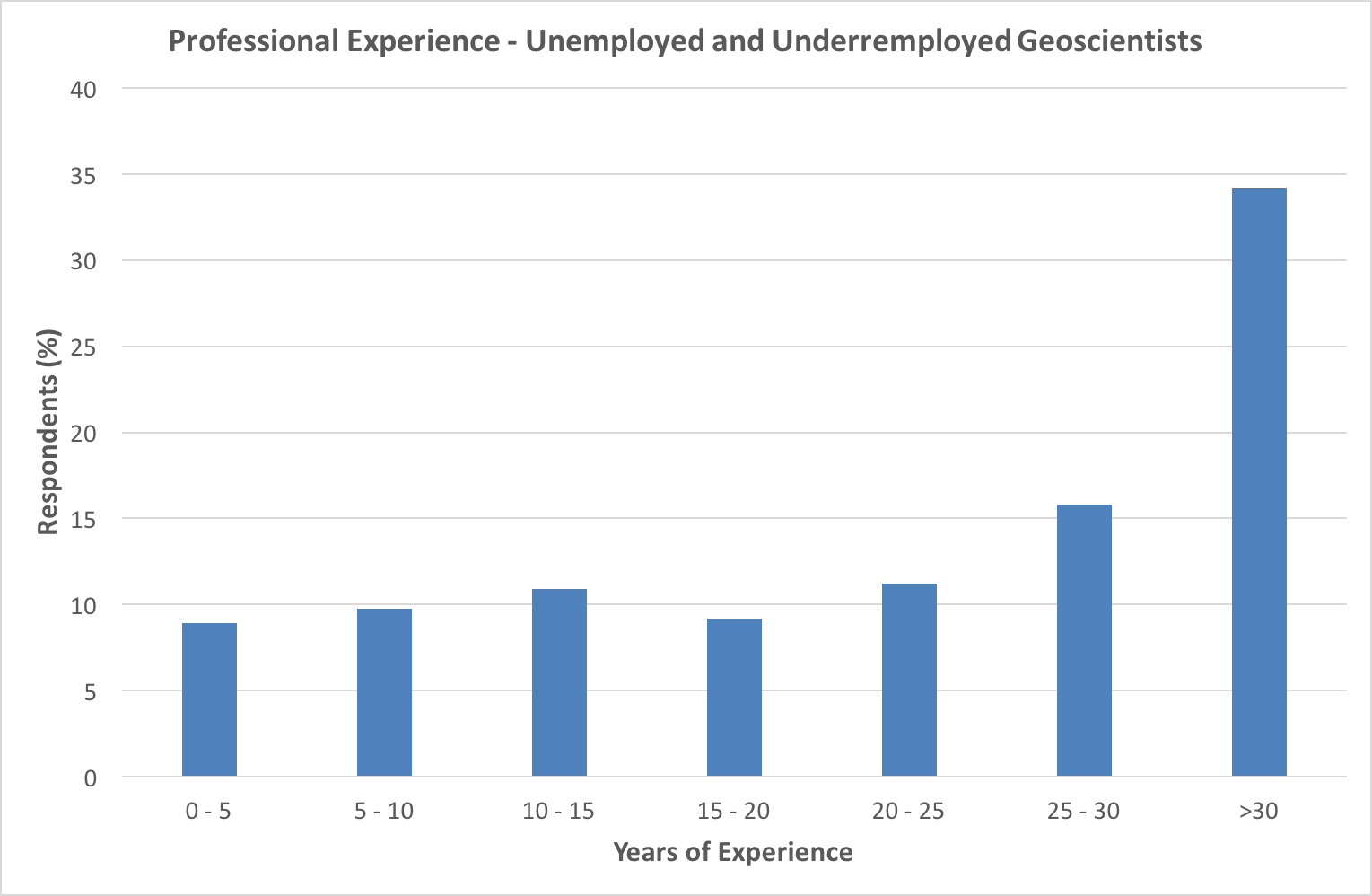
Figure 5. Professional experience amongst Australia’s unemployed and underemployed geoscientists
If anything in the survey results can be seen as positive, 43% of geoscientists in employment felt confident of maintaining their employment for at least the next 12 months; a marked improvement since December 2015 when only 36% of respondents felt confident of retaining employment.
The proportion of employed geoscientists in full time roles fell from 88% in December 2015 to 81% in the March 2016 survey. The proportion of survey respondents in employment describing themselves as self-employed increased from 9% in December 2015 to almost 15% in March 2016.
Some 15% of respondents currently in employment felt at risk of losing their jobs in the next three months: a similar result to that recorded by the December 2015 survey.
AIG President, Mr Wayne Spilsbury, expressed disappointment in the latest survey results. “Australian geoscience is entering its third year of extraordinarily difficult employment conditions for a group of educated, highly trained and experienced scientists.”
“When we think of geoscience in Australia, it is logical to immediately envisage professionals working in exploration and mining and forget that the skills developed and used in those aspects of professional practice are just as relevant to many other fields such as effective land management, environmental assessment, monitoring and remediation, and the management of groundwater resources that are so important to the future of large areas of Australia,” Mr Spilsbury said.
“Our minerals and energy resources industries too, are amongst Australia’s most productive, innovative, efficient and sustainable generators of wealth for our nation,” he said. “Every job in exploration and mining generates between three and four jobs in the broader community, from early stage exploration through to mine closure. “Australian companies are world leaders in delivering professional services covering the entire gamut of geosciences globally. Australian software plays a critical role in the effective execution of resource exploration and mining projects globally due to innovation based on local experience and expertise.”
“All this is at risk if we cannot crystallise investment in exploration,” Mr Spilsbury said. “These surveys, since 2009, have established a close link between geoscientist employment, exploration investment, resource discovery and the overall health of Australia’s mineral and energy resource industries”.
“All AIG members know that the factors responsible for the prolonged downturn in geoscientist employment are the same ones damaging Australia’s resource development project pipeline. These are low metal prices (except gold), poor sentiment in the equity market leading to lack of access to fresh capital and green and red tape that slow and often prohibits access to land for early, non-destructive, early-stage exploration.”
Although the results from this survey are the worst recorded since this series of surveys commenced in June 2009, there are a few signs of a possible turn-around in their fortunes”.
“The rate at which geoscientist unemployment has been increasing, particularly since September 2014, eased in the latest results,” Mr Spilsbury said. “The proportion of geoscientists currently in employment who felt confident about the security of their jobs increased, even if only slightly, for the first time in 18 months.”
The latest survey also revealed a small but sharp increase in the proportion of geoscientists in employment describing themselves as self-employed. “We’ve seen this in previous surveys, but at times when geoscience employment was in a better state than it is now,” Mr Spilsbury said. “AIG and its kindred professional institutes will be working hard to assist members making or considering a transition to self-employment,” he said.
“If there is light appearing at the end of the tunnel, then now is the best time to act to catalyse investment in exploration at State and Federal levels to take full-advantage of an emerging opportunity,” Mr Spilsbury said. “We need action to make this a reality.”
16 May 2016
The AIG Victorian Branch is offering a bursary to Third Year, Honours and Post Graduate Students studying full time for a degree in earth sciences to assist with the cost of attending conferences, workshops or field trips.
Funding is available to provide Victorian based AIG student members, who can demonstrate a need for support, with opportunities to participate in course related or professionally organised geological field trips, conferences and workshops.
The award of funding may be used for registration fees for conferences / courses / field trips and related travel expenses.
The field trip/short course/conference may be located in Australia or overseas, and must be of relevance to the applicants course.
Applicants are required to submit a proposal as a pdf document which will be assessed by a selection panel from the Victorian AIG Branch committee on an ad hoc basis.
The geoscientists who are awarded a grant will sign an agreement to use the funding for the purposes specified, a waiver indemnifying the AIG for any loss damages or injury sustained as a result of the trip/conference/course and will undertake to write a brief report (approximately one A4 page length including photo) for publication by the AIG.
Click here to download the application form.
Closing Date for Applications: 30 June, 2016.
The National Rock Garden will celebrate Australia’s rich geological heritage in a parkland setting within the national capital, with a permanent display, showcasing the diversity of the rocks, and minerals that contribute so significantly to the nation’s landscapes, heritage and prosperity.
The foundation stones are still all that mark the National Rock Garden site, just off Lady Denman Drive on the northwestern shores of Lake Burley Griffin in Canberra, but much is happening behind the scenes to bring the project to fruition.
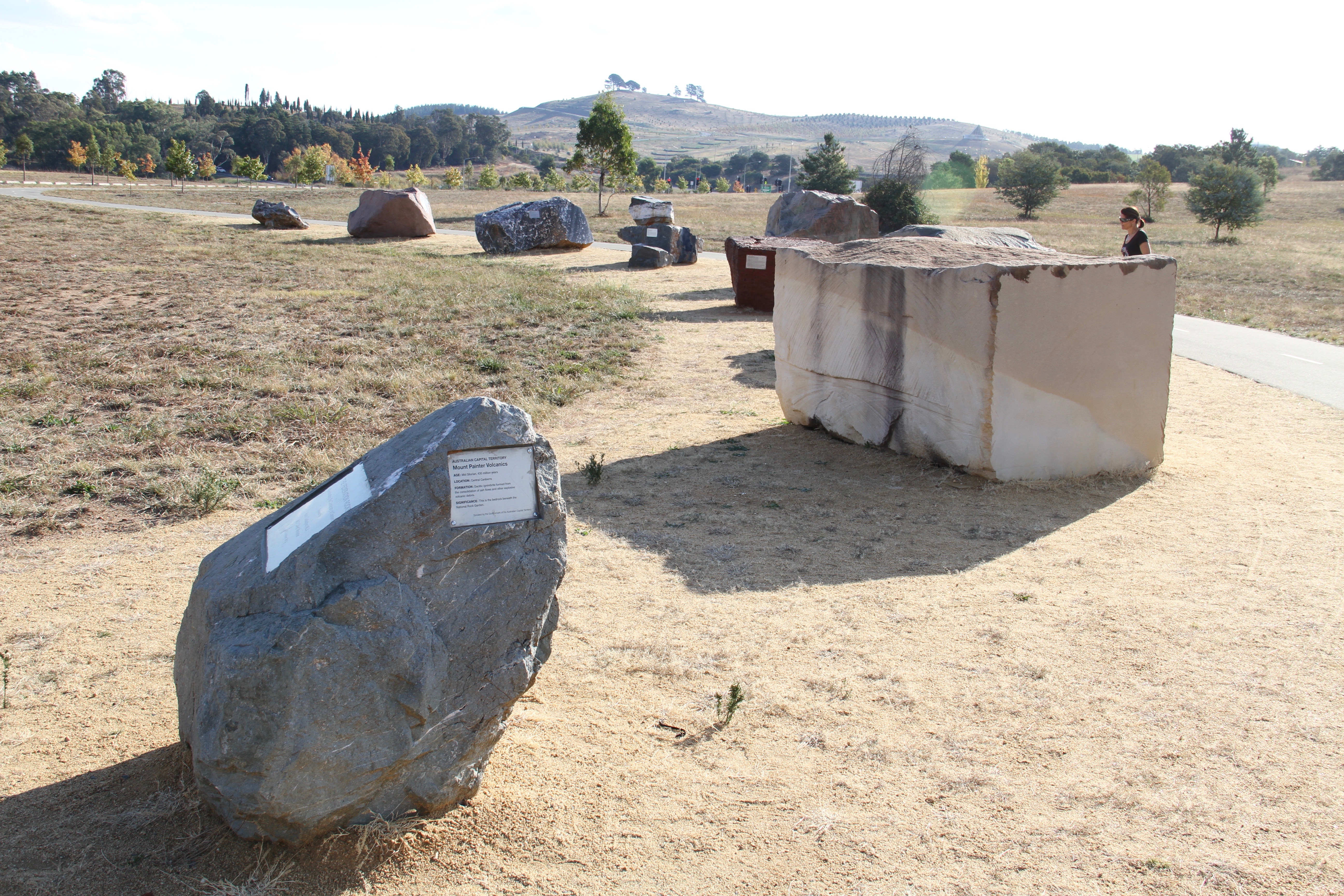
The National Rock Garden’s foundation stones mark the project site.

This sign outlines the project’s objectives to visitors.
A major aim of the National Rock Garden in the ACT is to promote earth science education to the general public, but particularly to school groups. Initial discussions with science educators from the Australian Science Teachers Association, CSIRO Discovery Centre and Geoscience Australia indicate that the NRG will be highly regarded and frequently visited, particularly by organised tours of school children and their teachers.
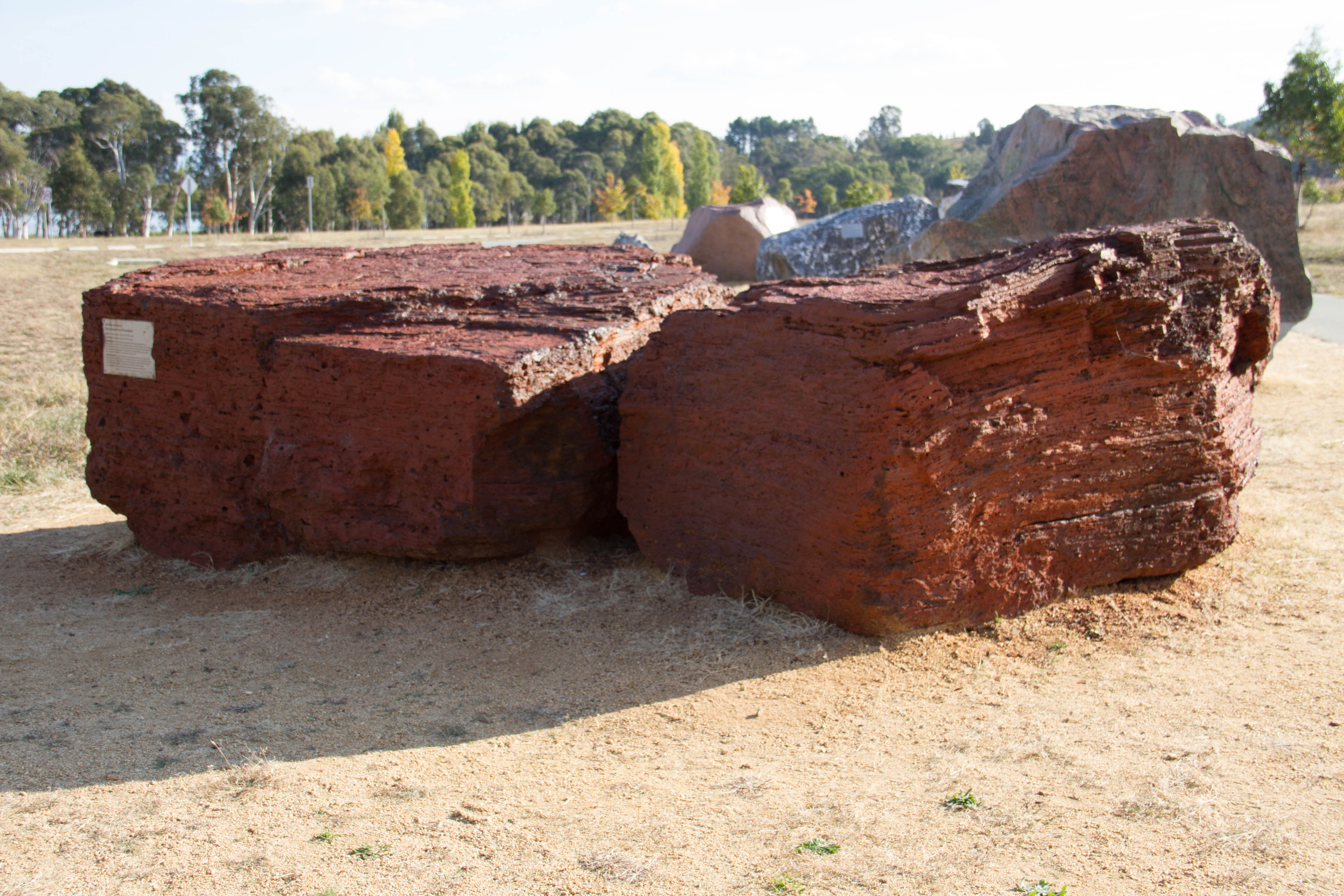
Brockton Iron Formation from Western Australia’s Pilbara region.
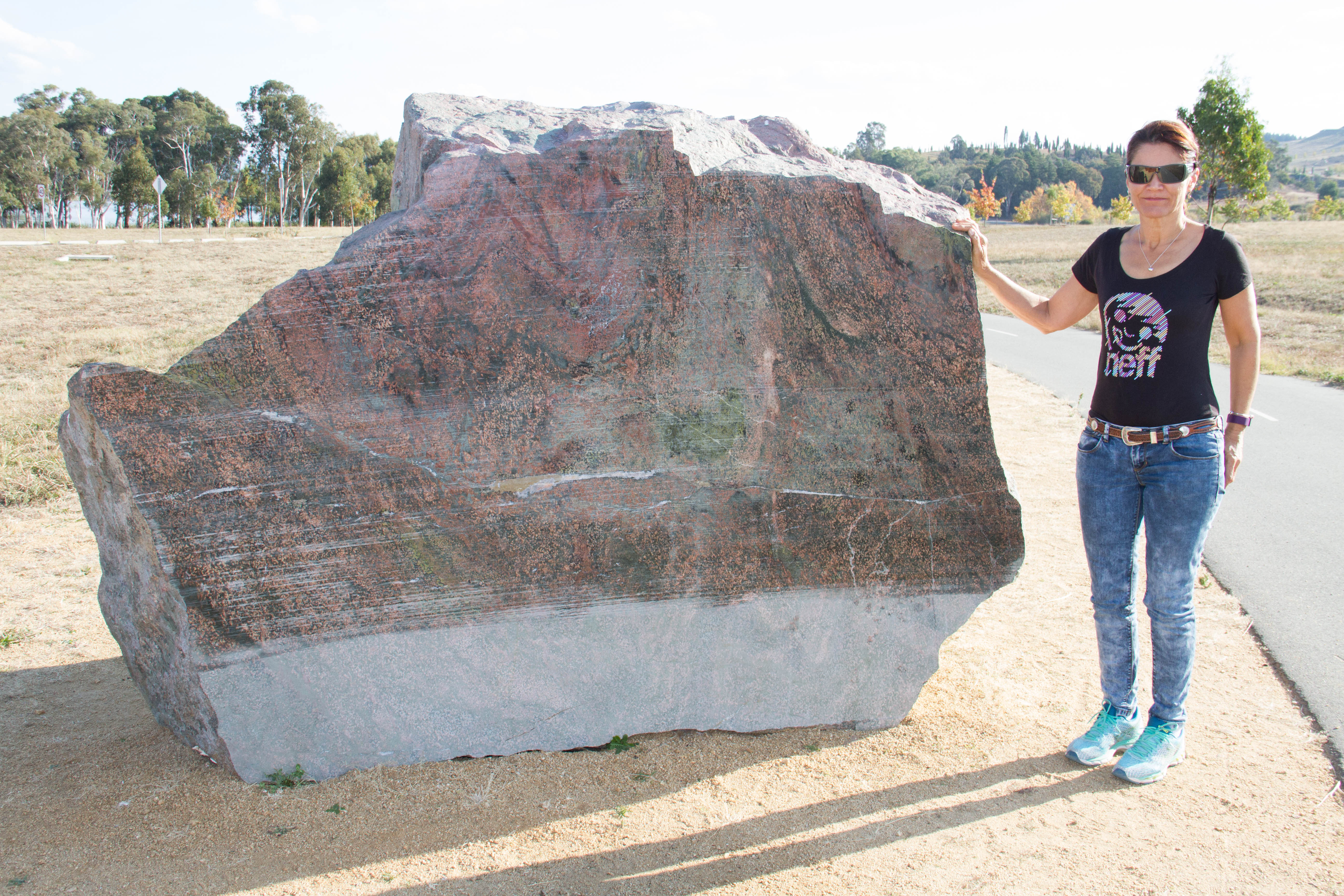
Oorlano Metasomatise from South Australia’s Yorke Peninsula.
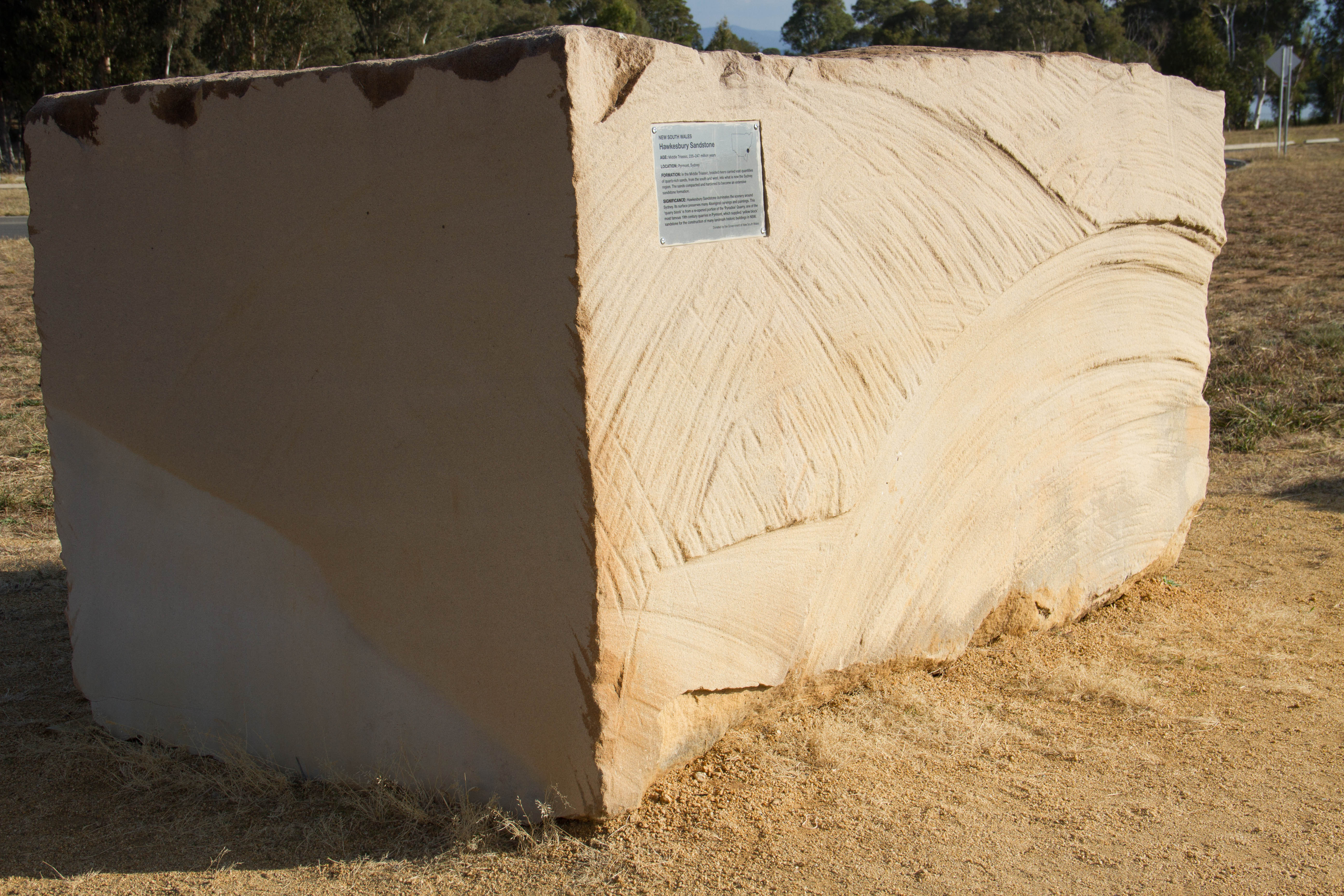
Hawkesbury Sandstone which forms the spectacular coastal cliffs of the Sydney region, New South Wales.
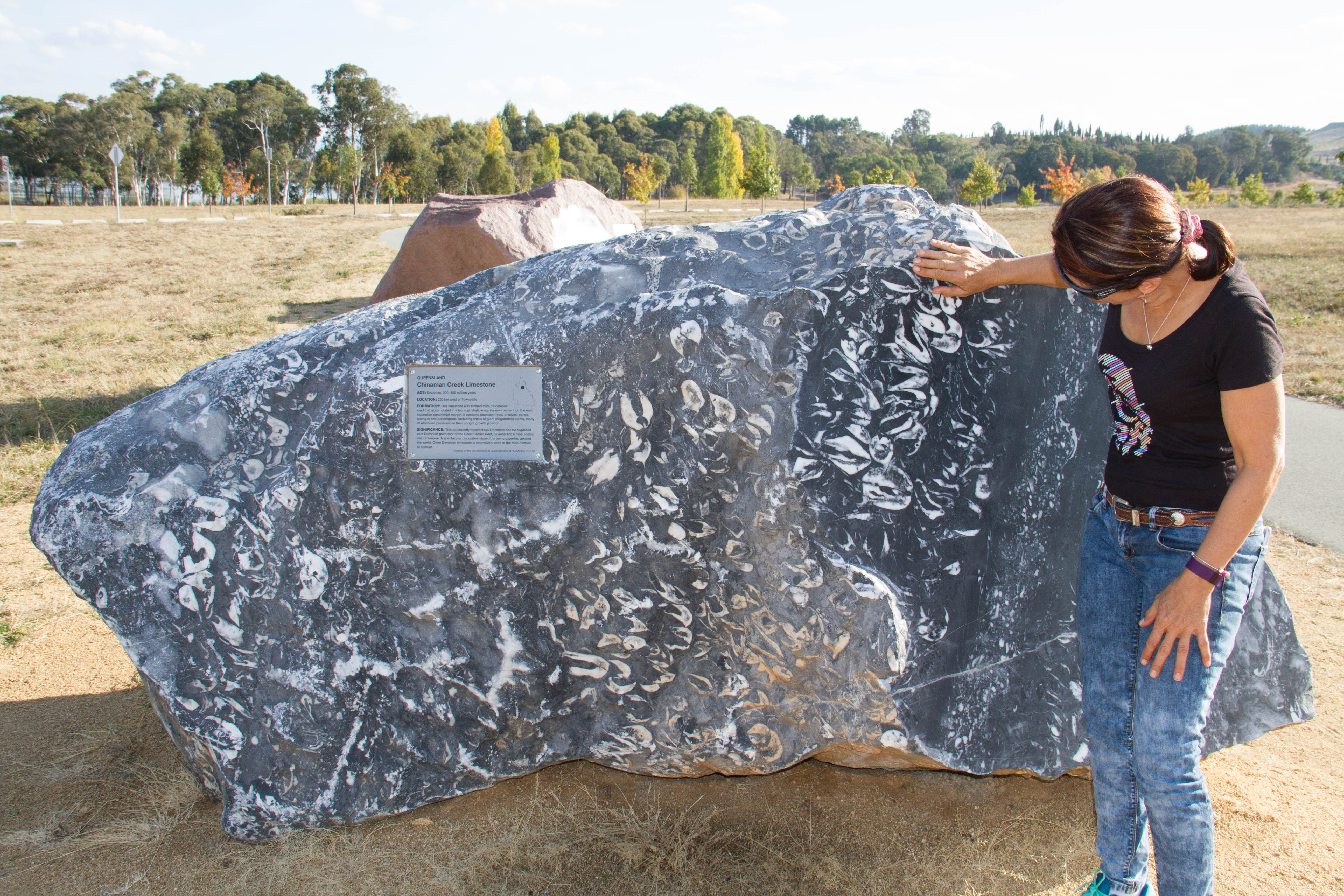
Queensland’s Chinaman Creek Limestone, a Devonian limestone exposed about 220 km west of Townsville.
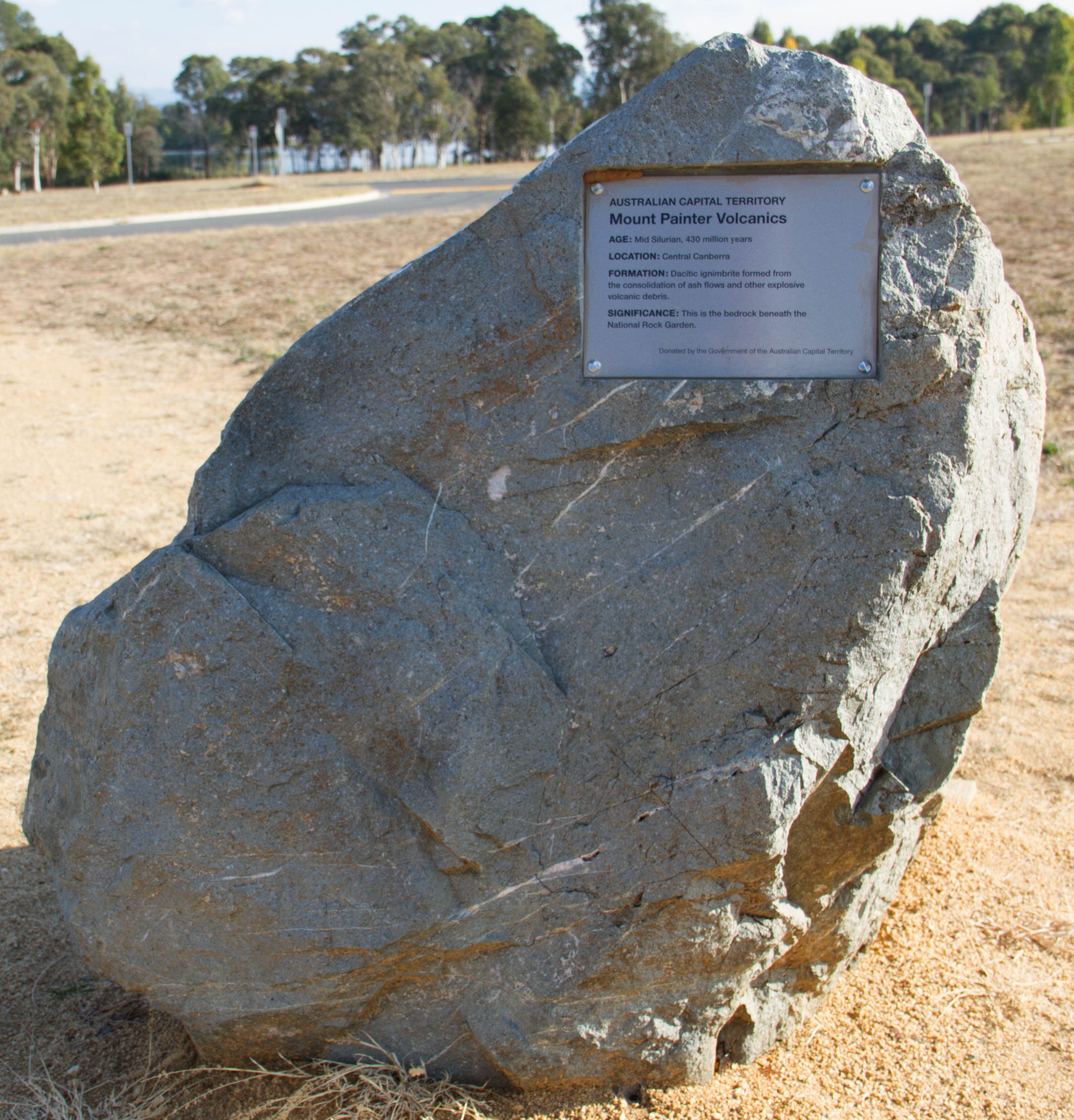
Some local geology – Mount Painter Volcanics from the Australian Capital Territory.
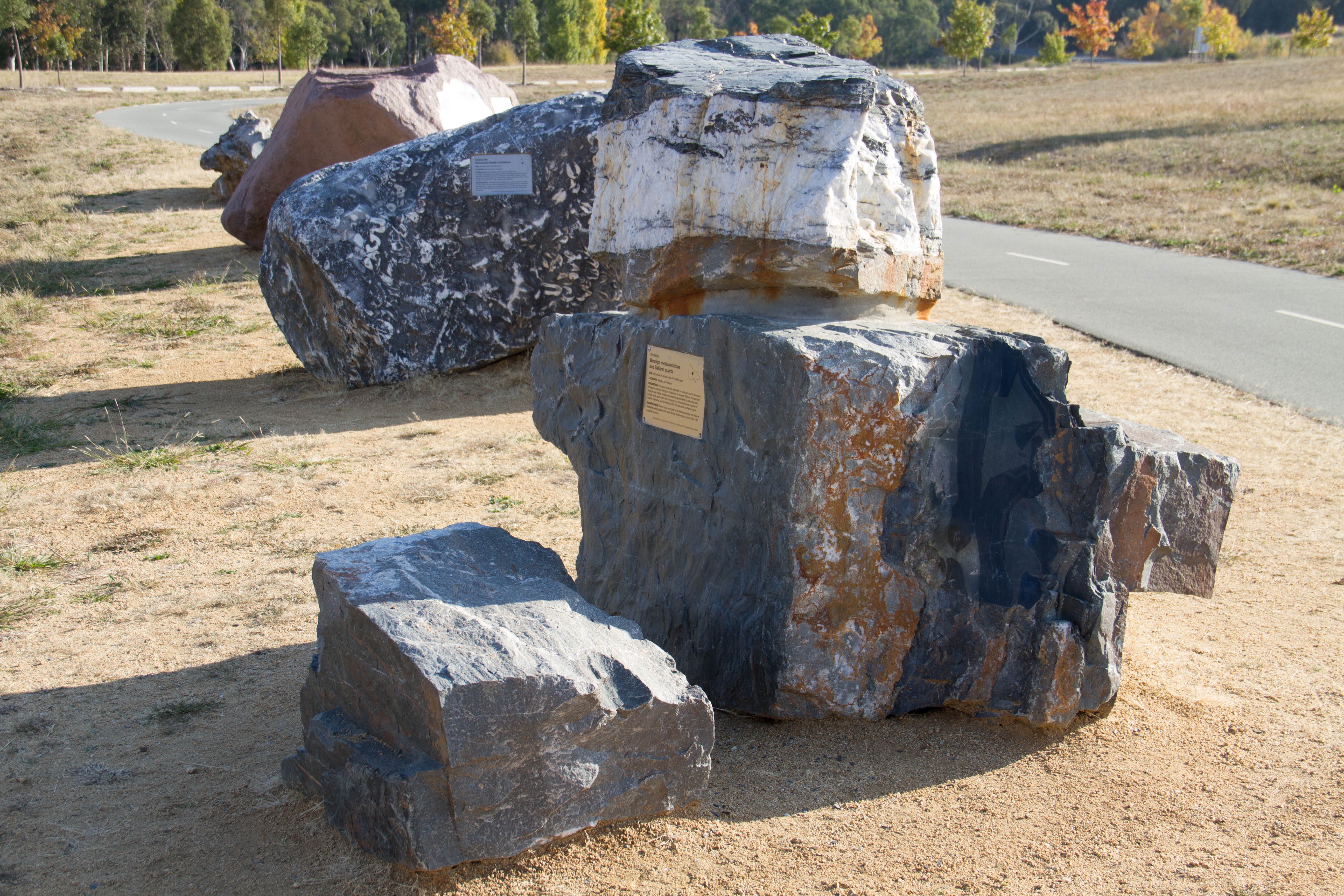
Bendigo metasandstone and Ballarat quartz from Victoria’s goldfields.
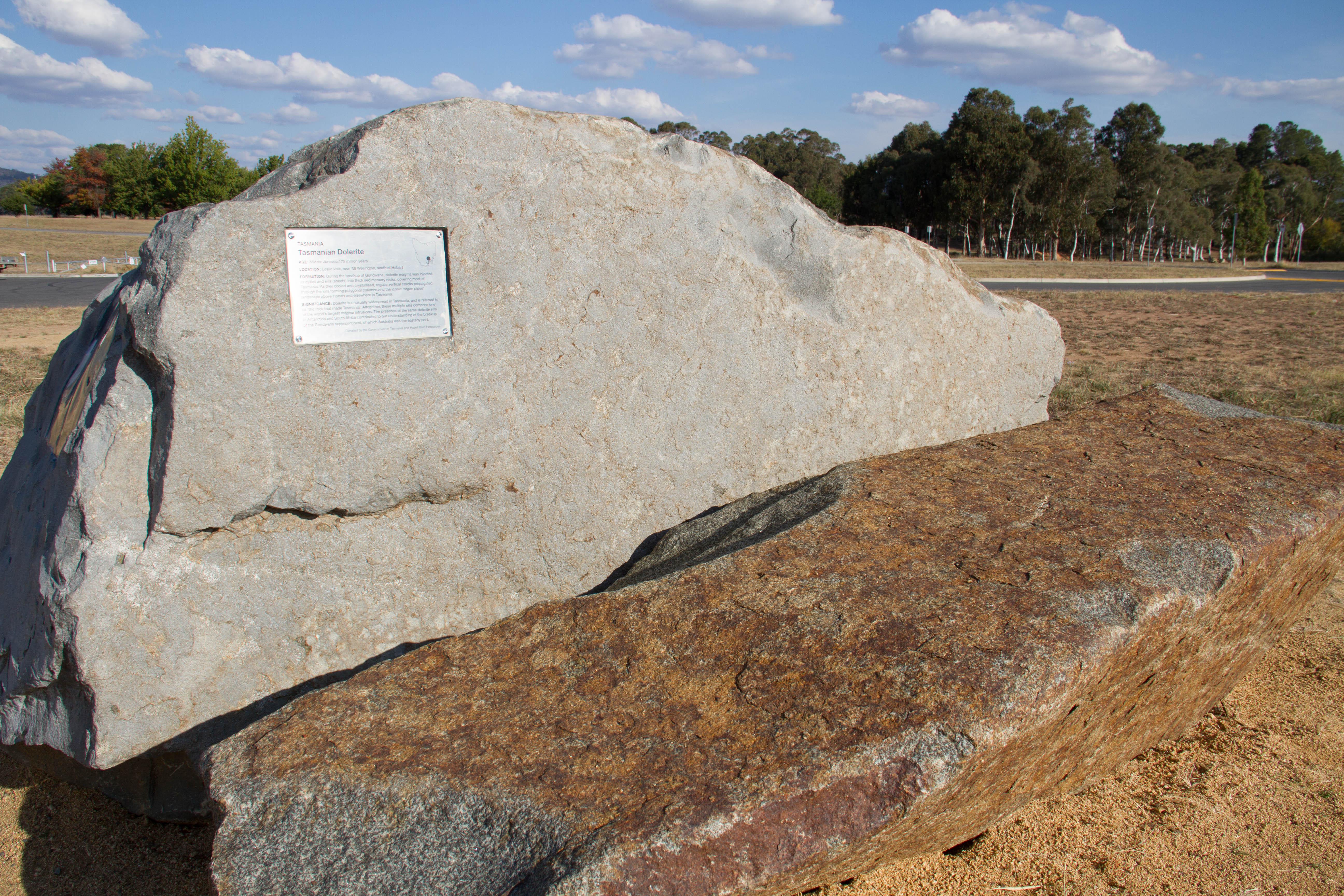
Tasmanian dolerite.
In recent months, the NRG Steering Committee has focussed on developing a plan for an Education Pavilion at the rock garden, to provide a spacious undercover area where visitors and school groups can gather to participate in learning activities with educators and geoscientists and where information on the NRG, as well as rare rocks can be displayed and securely stored. The plan is for a single-story building, 35 m long and about 12 m wide, capable of holding up to two bus-loads of visitors. The building will be oriented to capture a north view across the NRG site, towards Black Mountain.
The Steering Committee is pleased to announce that, in December 2015, the Australian Geoscience Council approved a grant of $30,000 to the NRG which will enable sketch plans for the Education Pavilion to be prepared by well-known architects Taylor Zulaikha Greer (TZG). TZG have worked closely with Taylor Cullity Lethlean (the landscape architects who designed the NRG draft masterplan), on other major projects in Canberra, including the National Arboretum and the National Botanic Gardens.
In January 2016, the three NRG Directors met with TZG Director, Peter Tonkin, as well as representatives of the National Capital Authority (who are responsible for managing Commonwealth land in Canberra), at the site of the proposed Education Pavilion to review design options. It is hoped that sketch plans will be completed by March. This will provide an exciting opportunity for a high-level NRG sponsor to earn naming rights for the pavilion and also enhance earth science education in Australia.
Ken McQueen
AIG Representative
National Rock Garden Steering Committee.
Photos and additional text by Andrew Waltho
The ANNUAL GENERAL MEETING will be held at 5:45pm, Wednesday 18 May 2016 at the Irish Club, 61 Townshend Rd, Subiaco, WA, 6008.
Electronic voting for vacant Council positions and a resolution proposing adoption of a revised, modernised constitution for the Institute will remain open until midday, 18 May 2016.
Candidate profiles, the proposed, revised AIG constitution, AIG’s existing Memorandum and Articles of Association and the Annual General Meeting are available to members via the AIG membership portal – click on the Member Login button at the top of every web site page.
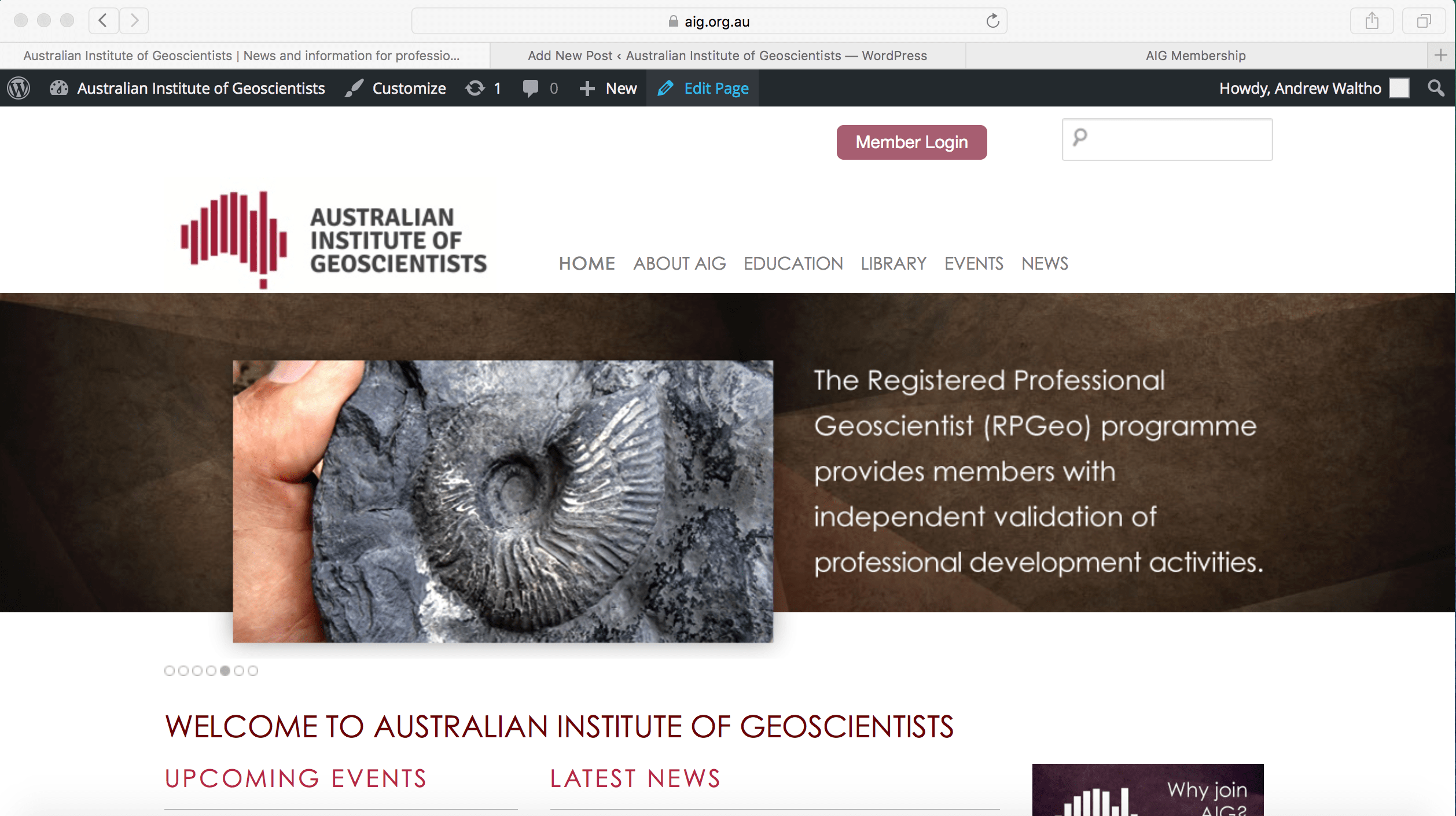
AIG Members, Fellows and Retired Members are eligible to vote in the election. Student, Graduate and Associate Members are able to review the Council election candidates and the draft AIG Constitution but are not eligible to vote.
All members have been provided with Membership Portal login credentials. Your username is usually your email address registered with the Institute. This may be different to the email address used to receive email newsletters. Use the Forgot Password link to reset your password if you are unable to recall it.
7 May 2016